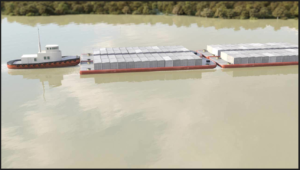Donlin and Barging
Fostering Good, Two-Way Communication
Storyknife, November/December 2022 edition
Barging is part of the way of life of the Yukon-Kuskokwim Region and has been for a hundred years: it’s how all of our villages receive fuel and freight during the ice-free season.

Graphic illustration of tug-barge set for the Donlin Gold Project.
Barging is part of the plan for the Donlin Gold Project, as well.
Community input has significantly reduced the number of barges that Donlin will use to deliver fuel and freight to the proposed mine.
However, during mine operations, an average of one to two double-hulled river barges per day serving Donlin will travel between Bethel and a new port at Jungjuk Creek, near Crooked Creek. This port will be owned and operated by The Kuskokwim Corporation (TKC). The river barge fleet will include four tug-and-barge sets: two for general cargo and two for diesel transport.
While studies by federal agencies and Donlin have shown that the barge traffic is unlikely to impact migratory fish populations, the uptick in traffic will be noticed by river communities.
“Especially during subsistence gathering periods, good, two-way communication between Donlin and communities will be vitally important.”
Tisha Kuhns, Calista Corp. Vice President of Land and Natural Resources
Local Input
What does good communication about barging look like? Plans are still taking shape and currently include:
- Twice-yearly meetings and updates where community members can learn about plans for the upcoming barge season and provide feedback after the barging season ends
- An online portal or smartphone app to view the current location and movement of Donlin barges
- Two-way VHF radio communications and/or cell phone calls (where coverage is available) between barges and other vessels
- A pilot vessel traveling ahead of the Donlin barges on high-traffic areas to observe river conditions and subsistence activities on the river
- Hiring Yup’ik-speaking crew members to operate the pilot vessels
- Regular newsletter, web and social media updates about barging plans
Avoiding Impacts To Smelt & Subsistence Fishing
Donlin began studying rainbow smelt seven years ago due to community concerns that barging could disturb their spawning habitat. Those studies show that the smelt generally spawn in the Kuskokwim River near Upper Kalskag, and primarily in areas of the channel not likely to be affected by barging. The continuation of smelt studies and the evaluation of potential barging effects are important to find additional ways to minimize effects to the rainbow smelt.
The Donlin Advisory Technical Review and Oversight Committee (DATROC), established in 2014 by Donlin Gold, Calista and TKC, has a key role in providing oversight over barging.
The DATROC will receive input by community advisory committees, including a subsistence committee now in the recruitment phase, and a barging committee. These advisory committees will review Donlin’s plans, operations and monitoring activities.
“We understand the importance of subsistence fishing along the Kuskokwim River. The members of DATROC expect and encourage discussions and information sharing on barging as a key topic for the subsistence committee,” says Dan Graham, general manager for Donlin Gold.
In other places with high vessel congestion—like Bristol Bay—experienced operators point to the importance of communication for seasonal barge and boater traffic.
Drew McIntyre, marine superintendent for Brice Marine, advocates for good VHF communications between vessels of all types.
“The individual boater generally doesn’t have a radio on them or doesn’t have it turned on,” he says. “However, it would be very useful, for safety, to know that entities can talk to each other.”